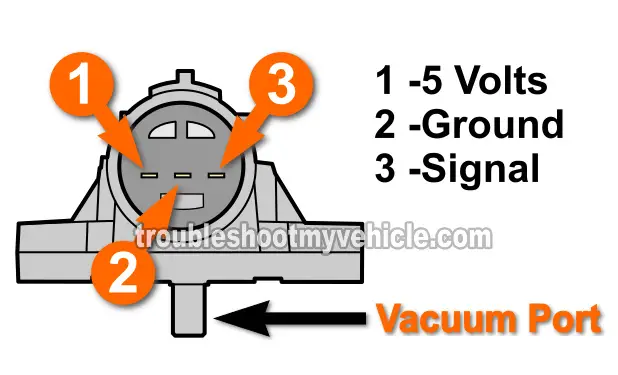TEST 3: Bench Testing The MAP Sensor

To better understand what all we're trying to accomplish with this last test, we need to remember that a P0108 DTC is telling us that the MAP sensor can no longer tell when the engine is under load.
When the engine is under load (think accelerating your Honda down the highway to pass someone), the MAP sensor should report a lower vacuum pressure, and it does this by sending the PCM a lower voltage signal on the MAP signal wire (circuit).
So, we're gonna' simulate this load by manually applying vacuum to the MAP sensor ourselves with a vacuum pump (or the good ole' lungs) and verifying that it's producing a low voltage output signal (with your multimeter).
This MAP sensor bench test, we're about to perform, will let us know beyond a shadow of a doubt if the MAP sensor is bad or not.
This is also a pretty easy and simple test and I'll show you how. This is what you'll need to do:
- 1
Remove the MAP sensor from the top of the intake manifold.
Reconnect the MAP sensor to its electrical connector, if you had to unplug it to remove it, since this test requires that the MAP sensor stay connected to its 3-wire electrical connector. - 2
Connect your multimeter's red test lead to the wire that connects pin number 3 of the MAP sensor.
You'll need to back-probe the MAP sensor connector or use a wire piercing probe to connect your multimeter to this circuit (to see what a wire piercing probe looks like, click here: Wire Piercing Probe). - 3
Ground the black multimeter test lead.
I suggest grounding the black multimeter test lead directly on the battery negative (-) terminal. - 4
Turn the key on (but don't start the engine) and take a look at what voltage your multimeter is registering.
It should register around 2.9 Volts (± 1 V). If your multimeter is registering something different at this point, don't panic because right now you're just setting up the test. - 5
Attach a vacuum pump to the MAP sensor's vacuum port using the appropriate size vacuum hose.
If you don't have a vacuum pump, you can use the ‘good ole' lungs’ and provide the necessary with your mouth. - 6
Apply vacuum to the MAP sensor.
- 7
The voltage should decrease as you apply vacuum with your vacuum pump (or with your mouth).
- 8
Release the vacuum you applied to the MAP sensor.
- 9
The MAP sensor's voltage should increase back to the original voltage value you saw in step 4 as you release the vacuum you applied with the vacuum pump (or your mouth).
Let's take a look at what your test results mean:
CASE 1: The MAP sensor's voltage decreased and increased as you applied and released vacuum. This confirms that the MAP sensor is good and operating normally.
This test result completely eliminates the MAP sensor on your Honda as bad. If you're still having the MAP sensor trouble code come back, take a look at: MAP Sensor Is Good But Code Doesn't Go Away!
CASE 2: The MAP sensor's voltage DID NOT decrease or increase as you applied and released vacuum. This confirms that the MAP sensor is bad and needs to be replaced.
If you need to buy the MAP sensor and would like to save some bucks, take a look at the section: Where To Buy The MAP Sensor.
MAP Sensor Is Good But Code Doesn't Go Away!
Several things can cause the PCM to think that the MAP sensor is bad when it really isn't (and set a MAP P0108 trouble code). In this section I'll offer a few tips and/or suggestions:
- Check engine mechanical health.
- This means doing a compression test.
- What you're looking for is uneven wear and tear between the cylinders. This means that the compression each cylinder is producing varies more than 15%.
- This tutorial will help: How To Test Engine Compression (Honda 2.2L, 2.3L).
- Make sure that the MAP sensor is getting power and Ground.
- Take a look at the following section: P0108 Basics You Need To Know.
- A short in the wiring between the MAP sensor and the PCM.
- You'll need to check the continuity of the 3 wires between the MAP sensor and the PCM using the appropriate wiring diagram.
- A bad PCM.
- A fuel system malfunction (that is also setting other trouble codes).
- If there are any other trouble codes, you'll need to diagnose and repair these first (since they may be indirectly causing the P0108 code).
- You've replaced the throttle body gasket and used silicone sealer on it and this sealer has plugged the MAP sensor's vacuum passage and/or orifice (I've seen this happen a lot!).
More Test Articles
If this article has helped, or in the least it has been informative, check the other in the Honda 2.2L, 2.3L index. You can find this index here: Honda 2.2L, 2.3L Index Of Articles.
Here's a small sample of the articles/tutorials you'll find in the index:
- P0107 Manifold Absolute Pressure (MAP) Circuit Low Voltage (Honda 2.2L, 2.3L).
- P0420 Catalyst Efficiency Below Threshold (Honda 2.2L, 2.3L).
- How To Find A Bad Fuel Injector (Case Study).
- How To Test A Misfire Condition (Honda 2.2L, 2.3L).
- How To Test For A Broken Timing Belt (Honda 2.2L, 2.3L).
- How To Test The Igniter, Ignition Coil Accord, Civic, CRV, And Odyssey (at: easyautodiagnostics.com).
- How To Bench Test A Starter Motor (Step By Step) (at: easyautodiagnostics.com).

If this info saved the day, buy me a beer!

